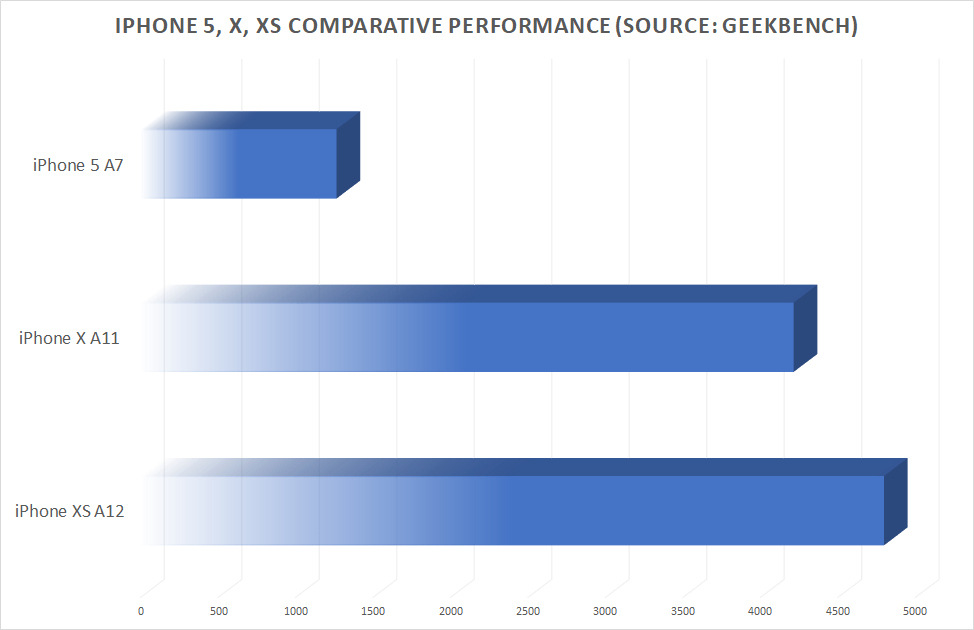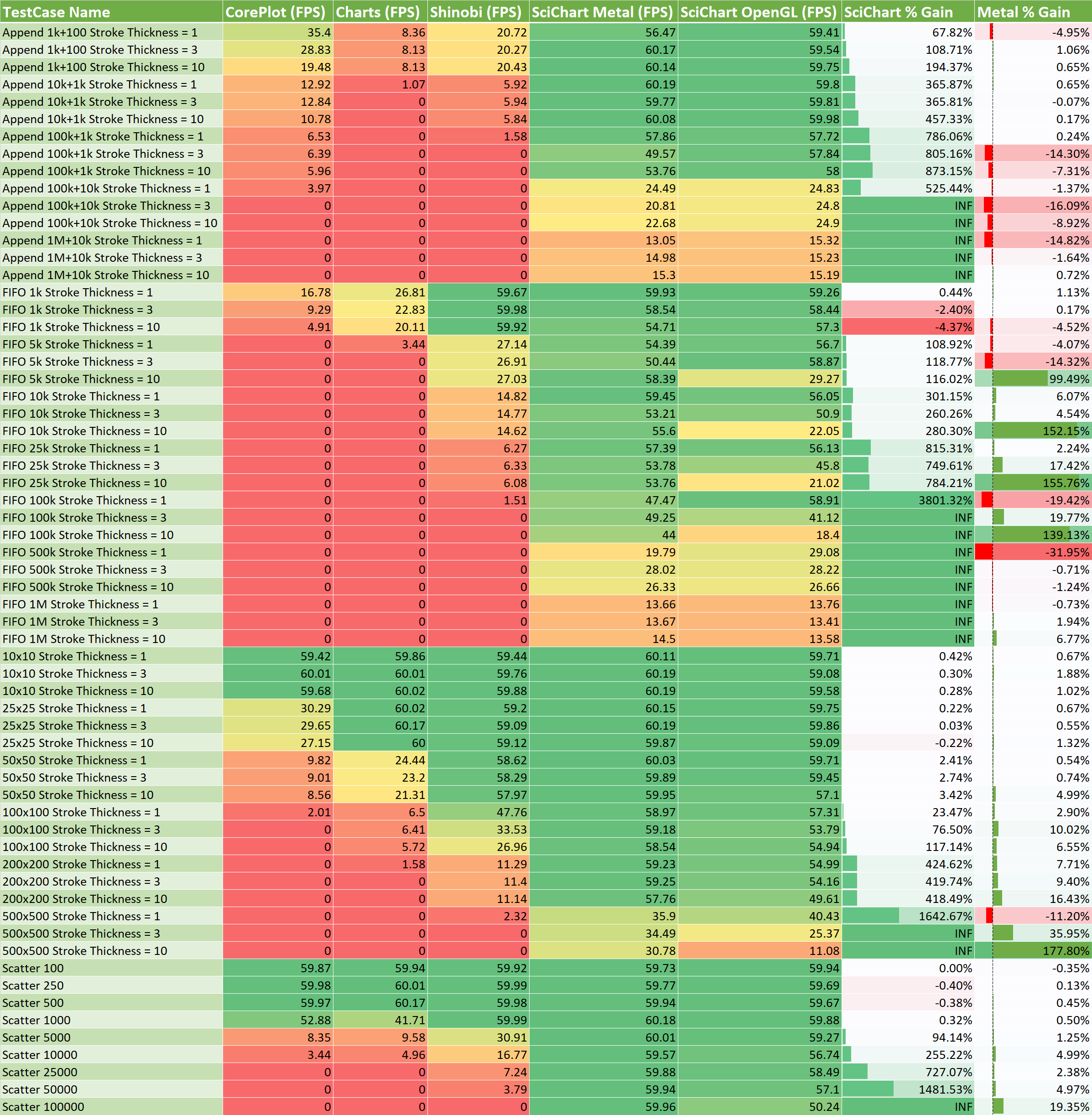
It’s been almost three years since we released SciChart iOS: Realtime Charts for the iOS Platform. Right from the start, our goal has been to create the worlds fastest iOS Charts, but also produce visually appealing, productive, easy to use and flexible / powerful iOS charting controls, capable of being used in demanding business apps.
Our first version of SciChart iOS beat the speed records of any previous known iOS Chart control and we have only worked to improve our chart performance since then. We realise though, that speed isn’t everything, and also have been focussing on flexibility so that we can provide a compelling offering vs. open source iOS Chart components.
However, if it’s iOS Chart Performance you are looking for, then you have come to the right place! With the recent release of SciChart iOS v2.5 with metal support, we have taken the opportunity to update present new performance results of our iOS Chart control: SciChart iOS, vs. a number of competing open source iOS charts and commercial charts, as well as demonstrate the performance differences in our iOS Charts between Metal & OpenGL rendering on a variety of devices.
Topics in this article include:
Test Setup
iOS Chart Frameworks Compared in this Article
In this article we compare the performance of the following chart controls:
- Core-plot; an Open source iOS Chart based on Core-graphics
- Charts; an Open Source iOS Chart based on Core-graphics
- Shinobi: a commercial iOS Chart library made by Scott Logic Ltd which uses OpenGL
- SciChart (with our OpenGL renderer plugin)
- SciChart (with our new Metal renderer plugin)
Tests Carried out
A number of tests are carried out to really stress the chart controls, these are:
Test 1: Hundreds of Series Line Chart Test
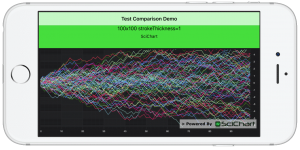 In this test, tens or hundreds of series, with tens or hundreds of points are added to the chart, then the chart redraws (the same data) as fast as possible by just resizing the Y-Axis for 10 seconds per test.
In this test, tens or hundreds of series, with tens or hundreds of points are added to the chart, then the chart redraws (the same data) as fast as possible by just resizing the Y-Axis for 10 seconds per test.
Performance is measured as FPS (Frames per second) using the CADisplayLink , which fires once after each drawing pass completes.
Test 2: Big-Data Scatter Chart Test up to 100k points
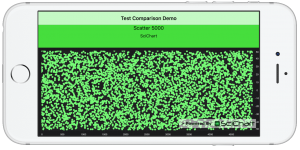 In this test, thousands or hundreds of thousands of Scatter points (ellipses) are appended to a series, then the chart redraws. Immediately after, the point positions are updated in a Brownian motion fashion and the chart is drawn again.
In this test, thousands or hundreds of thousands of Scatter points (ellipses) are appended to a series, then the chart redraws. Immediately after, the point positions are updated in a Brownian motion fashion and the chart is drawn again.
Performance is measured as FPS (Frames per second) and recorded.
Test 3: Realtime Scrolling Chart Test up to 1 Million points
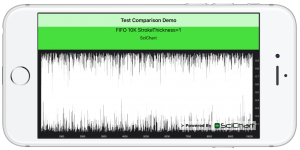 In this test, hundreds of thousands or even up to one million points are appended to a line chart, but scrolled from right to left (as new points arrive, old are discarded). SciChart for iOS & Android has a built-in mode to handle this called Fifo data series which use a circular buffer. Other chart components you can simply remove a point for each point added.
In this test, hundreds of thousands or even up to one million points are appended to a line chart, but scrolled from right to left (as new points arrive, old are discarded). SciChart for iOS & Android has a built-in mode to handle this called Fifo data series which use a circular buffer. Other chart components you can simply remove a point for each point added.
Test 4: Realtime line drawing test up to 10k Points added per second
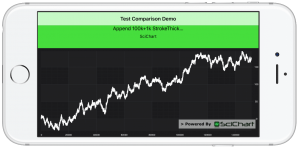 Performance is measured as FPS (Frames per second) and recorded. In this test we start off with a line chart with thousands or even tens of thousands of points. We then add hundreds or thousands of points per second to the chart, so that the series gets bigger very fast. The data is random-walk and the chart automatically zooms to fit when data is updated. This gives the appearance of a live streaming realtime chart.
Performance is measured as FPS (Frames per second) and recorded. In this test we start off with a line chart with thousands or even tens of thousands of points. We then add hundreds or thousands of points per second to the chart, so that the series gets bigger very fast. The data is random-walk and the chart automatically zooms to fit when data is updated. This gives the appearance of a live streaming realtime chart.
Performance is measured as FPS (Frames per second) and recorded.
Test Hardware
For the Test Hardware, we’ve used three phones: an iPhone 5s, iPhone X, and iPhone XR. The results are interesting as they show the strengths and weaknesses of each phone when drawing realtime iOS Charts using both Metal and OpenGL.
Performance Test Results
Interpreting the Test Results
Below: All test result numbers are in FPS (Frames per second – Higher is Better), meaning, the average number of redraws per second during the test, as measured by CADisplayLink.
The Test Case Name column is understood as follows:
- Append 1K+100 StrokeThickness = 1 means “Starting with 1,000 points on an iOS Line chart, append 100 new points in a loop with a stroke thickness of 1”
- Append 100k + 10k Strokethickness = 3 means “Starting with 100k points on an iOS line chart, append 10k new points in a loop with a stroke thickness if 3”
- FIFO 10k Stroke Thickness = 3 means “Load 10k points to an iOS Line Chart and scroll them to the left with a strokethickness of 3”
- FIFO 1M Stroke Thickness = 1 means “Load 1 Million points to an iOS Line Chart and scroll them to the left with a stroke thickness of 1”
- 100 x 100 Stroke Thickness = 3 means “Load 100 line chart series, to an iOS Chart, each with 100 points, with a stroke thickness of 3 and redraw the chart”
- 500 x 500 Stroke Thickness = 1 means “Load 500 line chart series to an iOS Chart, each with 500 points, with a stroke thickness of 1 and redraw the chart”
- Scatter 1000 means “Load 1,000 points to an iOS Scatter Chart and repeatedly draw the chart”
- Scatter 100000 means “Load 100,000 points to an iOS Scatter Chart and repeatedly draw the chart”
The Results Columns (Core Plot, Charts, Shinobi, SciChart Metal, SciChart OpenGL) are understood as follows:
- Numbers are in FPS (Frames per second), where higher is better. 30 FPS or above is smooth to the human eye.
- Each iOS Chart has FPS reported for this test case.
- SciChart iOS has FPS reported for both the OpenGL Renderer plugin and the new Metal Renderer plugin
Because many of the open source iOS charts we tested became unstable as dataset size increased, we skip running further tests once a chart has dropped below 5FPS. So a zero in a column means that test was skipped (the iOS Chart control was unable to render that data size).
Note that in the case where SciChart was able to run a test but other iOS Charts could not, the percentage gain was marked as INF (infinite).
The % Gain Columns are understood as follows:
- SciChart % Gain: The Max FPS of SciChart (Metal or OpenGL) is compared to the Max FPS of open source or commercial charts and computed as a percentage.
- e.g. 800% means SciChart was 800% faster than the fastest competing iOS Chart Control for this test case
- whereas -5% means SciChart was 5% slower than the fastest competing iOS Chart Control for this test case.
- Metal % Gain: The FPS of ScChart when Metal was enabled is compared to the FPS when OpenGL is enabled and computed as a percentage.
- e.g. 99% means SciChart’s Metal renderer was 99% faster than OpenGL for this test case
- whereas -15% means Metal was 15% slower than OpenGL for this test case.
Test Results iPhone X
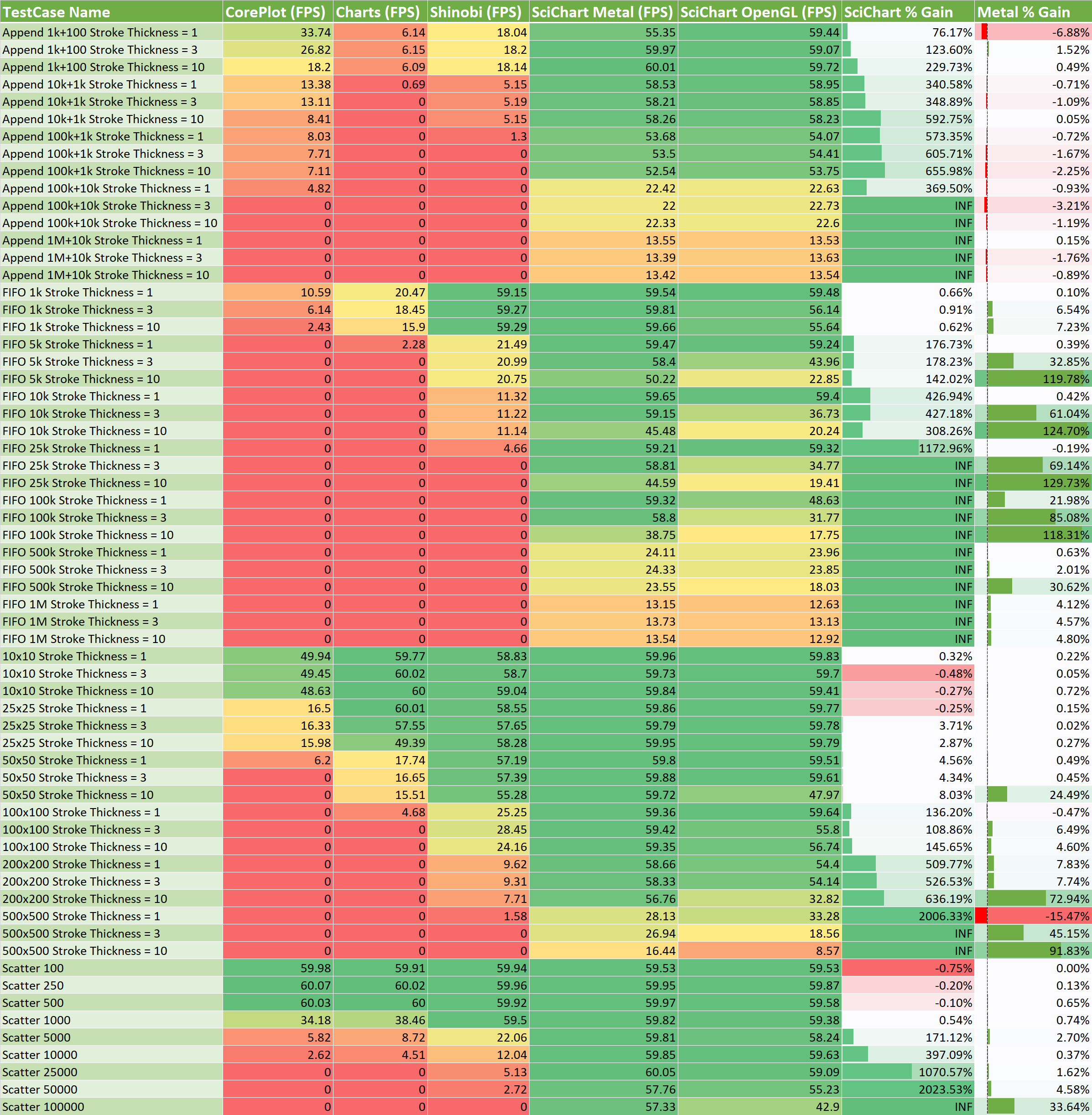 SciChart iOS Performance Comparison vs. Open Source Charts with Metal/OpenGL on iPhoneX.
SciChart iOS Performance Comparison vs. Open Source Charts with Metal/OpenGL on iPhoneX.
The iPhoneX shows strong performance results for SciChart, where our Metal rendering plugin is able to draw big data and real-time updates at smooth frame rates.
On an iPhone X, SciChart’s iOS Chart can draw:
- A massive 100,000 scatter points at 60 FPS (nearest competitor can only draw 1,000 points at the same frame rate)
- 200 series with 200 points on a single chart at 56 FPS (nearest competitor can only draw 50 series)
- 100k points scrolling in the FIFO case at 58 FPS (nearest competitor
- It can have 100k points on screen and append 1,000 new points at 54 FPS
 SciChart iOS Chart Performance is 60FPS for 100k points, 200 series or 100,000 scatter points in real time on iPhone X
SciChart iOS Chart Performance is 60FPS for 100k points, 200 series or 100,000 scatter points in real time on iPhone X
On an iPhone X, SciChart is considerably faster than competitors, with test cases up reporting up to 2,000% faster than the nearest competing iOS Chart component.
 SciChart iOS Chart Performance gain is up to 2000% faster than competitors on an iPhone X
SciChart iOS Chart Performance gain is up to 2000% faster than competitors on an iPhone X
Finally, SciChart’s Metal renderer plugin shows strong performance, with most cases comparable to SciChart’s OpenGL plugin. Some cases, a performance boost of over 100% is realised just by using the Metal renderer.
Test Results iPhone XS
 SciChart iOS Performance Comparison vs. Open Source Charts with Metal/OpenGL on iPhoneXS.
SciChart iOS Performance Comparison vs. Open Source Charts with Metal/OpenGL on iPhoneXS.
On the iPhone XS we have even stronger performance results. The iPhone XS is a really powerful device with a 6-core A12 Processor, vs a 6-Core A11 in the iPhone X. The iPhone XS also has a 4-core GPU vs. a 3-Core GPU in the iPhone X, and provides up to 50% faster graphics performance (source: Forbes – iPhone XS vs. iPhone X, What’s the Difference?).
This is reflected in the performance results. While some of the cases are comparable to the iPhone X, some are up to twice as fast. SciChart iOS is still able to draw hundreds of thousands of scatter points at 60 FPS, and now 500 series at 30 FPS, or a half a million points in a realtime scrolling chart at just under 30 FPS. Truly a big-data iOS Chart control. For the fastest test case SciChart iOS performs 3,800% faster than the nearest competitor.
Test Results iPhone 5s
 SciChart iOS Performance Comparison vs. Open Source Charts with Metal/OpenGL on iPhone5S.
SciChart iOS Performance Comparison vs. Open Source Charts with Metal/OpenGL on iPhone5S.
We’ve included the iPhone 5s as a testing device in our set of tests as well. The iPhone 5s is the oldest iOS Device which supports iOS 12 and Apple’s Metal graphics API. Because the processor is older and graphics processor less powerful, it isn’t as fast as the newer devices.
You can see a table of the Apple processor benchmarks over at browser.geekbench.com/ios-benchmarks.
The iPhone 5s has a processing power approximately 1/4 of the iPhone X and XS, so it is not a surprise that SciChart iOS is performing slower on these devices. However, it is still outperforming competing iOS Charts by a long way.
You will also note that Metal performance on the iPhone 5s is slower than OpenGL, in some cases up significantly slower. This is because the A7 processor in the iPhone 5s has less powerful GPU features than newer devices. It is therefore advisable to detect operating system and device before applying the Metal rendering plugin in SciChart iOS. You can find out how in our iOS Chart Documentation.
Conclusions
It’s hard to draw much conclusion from these test results other than SciChart’s iOS Chart Control is really, really fast!.
> SciChart iOS: Up to 3,800% faster than competing iOS Charts, able to draw millions of points in realtime
These kind of performance results may seem over the top however consider that mobile computing is really starting to grow as a platform not just to surf the web and use simple apps, but actually create real big-data utility applications for scientists, engineers, medical professionals and businessmen.
Datasets are only getting larger, and the performance demands of applications are growing. With SciChart’s iOS Charts you can add visually appealing, animated line, column, scatter, bubble charts to your iOS application, or, create new kinds of apps that enable you to visualise massive amounts of data. Never before has this second case been possible for developers of iOS Applications.
Verifying the Results
If you wish to verify the performance test results, we are happy to share a copy of our iOS Chart Performance Comparison app on request.
Why SciChart?
SciChart provides powerful, flexible, high-performance realtime iOS Charts, Android Charts and WPF Chart controls to thousands of users in 80 countries. Our customers have use SciChart to create completely novel iOS apps such as capturing and displaying large volumes of heart-rate data during physical training sessions, for realtime visualisation of cardiovascular data for medical diagnostics, visualising telemetry and more. Without SciChart’s High Performance iOS & Android charts, these kind of apps would simply not be possible.
Far from just a fast 2D line or scatter chart, our iOS, Android & Windows (WPF) Charts are powerful, flexible, fully-featured chart controls and provide a compelling alternative to open source and commercial chart libraries. You can find out more about SciChart in the articles Comparison of SciChart vs. Open Source Chart Controls, and Why SciChart, the Best WPF Charts.
For more information about how some of our customers have used SciChart iOS, please see our case studies. We have included some below, and the full set is available at online. If you have any questions, or wish to get in touch to discuss what SciChart can do for you, then please contact us.
Big-Data iOS/Android Chart Case studies

Avicena Heart (iOS)
Avicena is a medical device company focused on providing critical information to patients and physicians through their mobile app. Bespoke proprietary sensors stream cardiovascular data directly to a mobile device via Bluetooth to aid in diagnosis. Avicena chose SciChart as a reliable iOS charting solution to display Realtime, High-Bandwidth Cardiovascular data in up to 90 series streamed from sensors whilst maintaining a smooth UI and allowing for bespoke customizations and annotations.

iHealth Technologies Ltd (iOS)
Ihealth needed to display 70,000 points of Realtime Cardiac data for their revolutionary health and fitness app.
Custom iOS Charts were integrated alongside their existing styling adding great features and maintaining a smooth UI.
Keen to know more? Click below and find out what SciChart did to get this project off the ground!

IMT AG (Android)
IMT AG’s custom hardware project, the Citrex H5 had a range of hardware and cost requirements. SciChart was able to work with these and get IMT’s Android powered Gas Flow Analyzer off the ground with custom features and a slick high-performance interface despite the limitations of low-cost embedded hardware.
Read on to learn more and have a look through our full case study.
Related Posts
